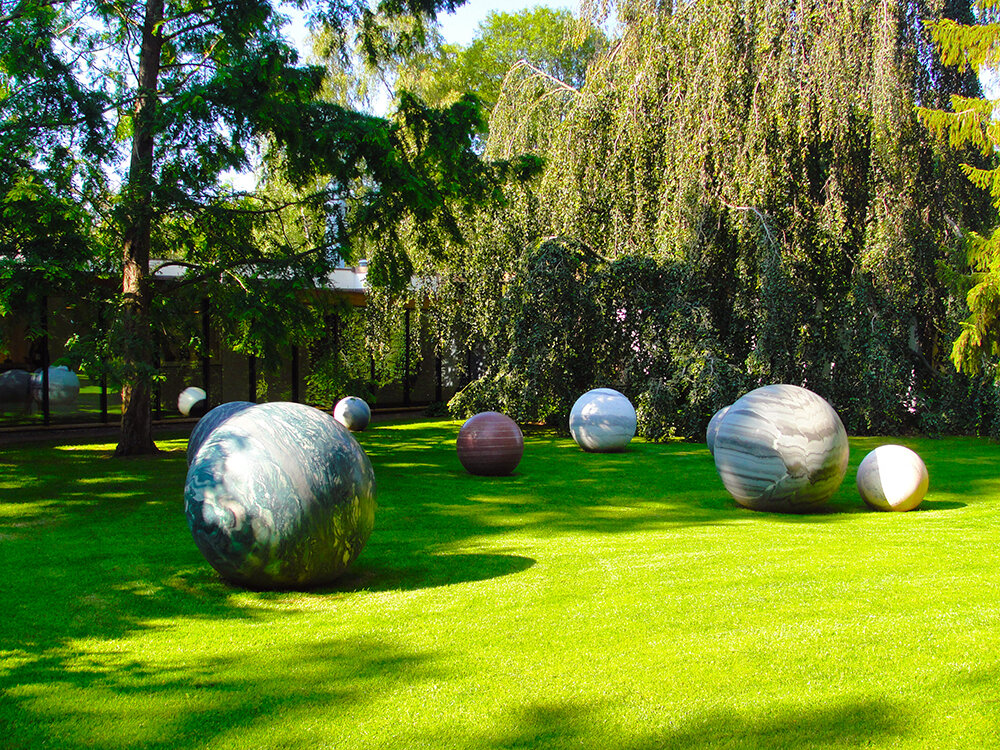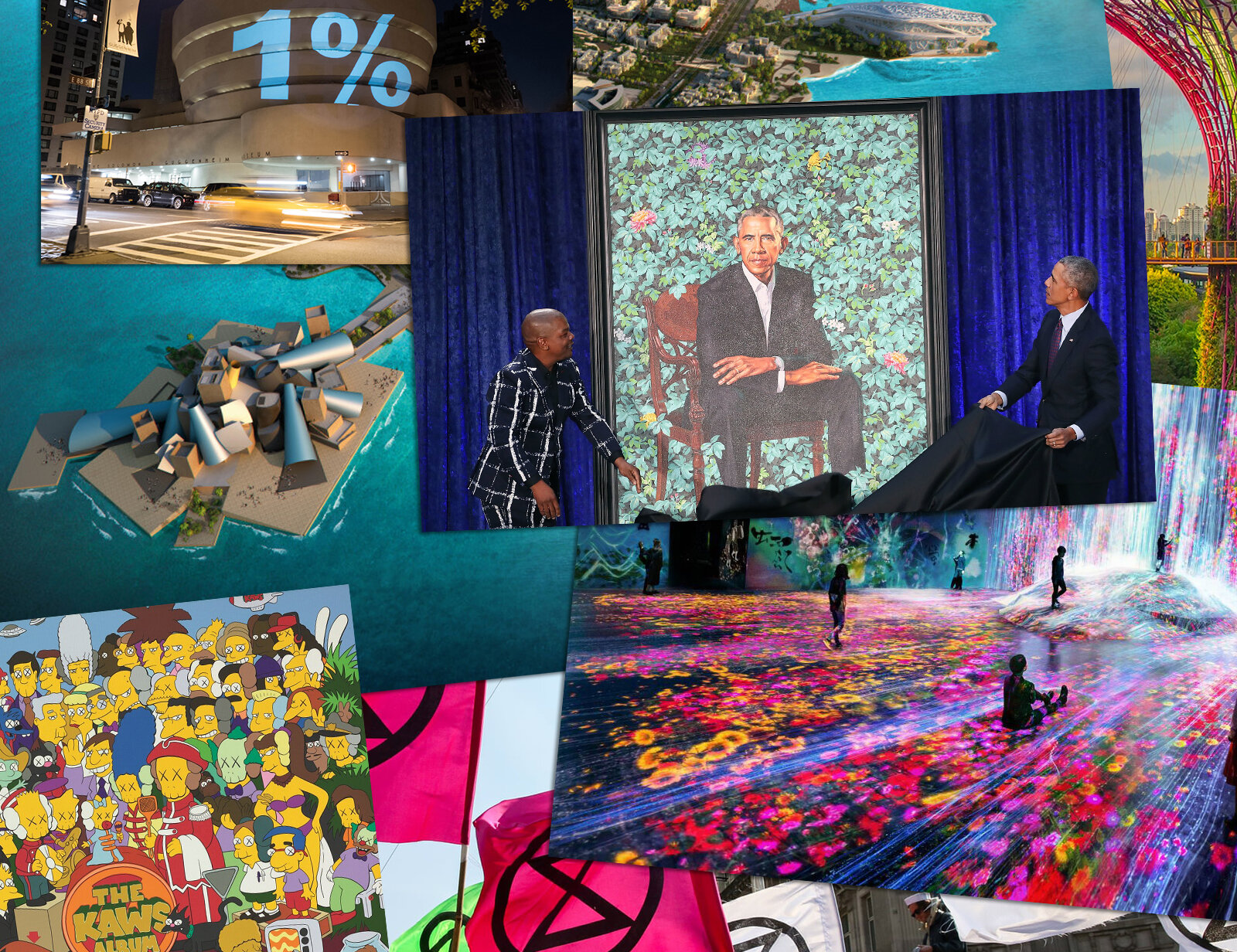Understanding Alicja Kwade

Kwade investigates our shared reality through a nihilistic lens that offers a refreshing — if challenging — perspective in these turbulent times.
Cover photo: Installation view of Alicja Kwade’s Moving in Glances exhibition in the Dallas Contemporary, Dallas, Texas, United States of America (2019).
Alicja Kwade
I first encountered Alicja Kwade’s work in the Venice Biennale a couple years ago. I must admit I didn’t think much of it initially. A few mirrors, a few stone spheres: I found it playful but indigestible. I encountered her work again in London, then New York, and then Humlebæk, so when I heard that the Dallas Contemporary would host an exhibition of her work I felt obliged to finally learn about it.
I’m very glad I did. To hear Kwade’s perspective adds a level of richness to her creations that is absolutely unattainable otherwise. Behind their brutal exterior, Kwade’s works hide observations about our strange world. Observations I’m still making sense of.
Reality
“Reality is an abstract term we feed with definitions we agree on in order to live together. It’s like the measurement, weight, or value system—it’s all invented,” Alicja Kwade argues. Born in Katowice, Poland, in 1979, and now living in Berlin, Kwade is unrelenting in her search for meaning. Her art interrogates reality, convention, and society.
“A country, a timezone, it’s all abstract meanings. I mean, there’s no countries. There are no borders. It’s like all decisions we do and we agree on,” Kwade announced while in a conversation with adjunct curator Pedro Alonzo.
Kwade is heavily inspired by contemporary philosopher and historian Yuval Harari, who has thoroughly documented the absurd world we have created for ourselves. He explains, “We humans control the world because we live in a dual reality. All other animals live in an objective reality. Their reality consists of objective entities, like rivers and trees and lions and elephants. We humans, we also live in an objective reality. In our world, too, there are rivers and trees and lions and elephants.”
Kwade attempts to make ethereal concepts tangible, through the use of pure materials like copper and stainless steel. Art critic Melissa Amore writes, “Engaged with scientific theory and social conventions used to perceive reality, [Kwade] employs the language of sculpture and architecture to examine the origins of perception and measure how information is transferred to an object or form.”
Civilization
Kwade has risen in popularity over the last few years. Most recently, she was asked to create an artwork for the Metropolitan Museum’s Roof Garden, a truly prestigious commission. Kwade created a complex pair of sculptures reminiscent of an astronomical instrument interacting with celestial planets. The resulting pieces draws upon the cosmos, time, and human civilization.
Each planet is a different stone, hailing from a different country. “It’s crazy, when you think about it—these stones spheres are compressed time,” Kwade explains. “They’re metaphors. But what I like about them is that we are really standing on a giant stone, Earth. And that’s what I mean about a double reflection. You realize you are standing on a stone like the kind you are looking at.”
The intersecting metal squares frame the New York skyline atop one of the world’s most celebrated institutions. It is a remarkable image, a crown for humanity’s accomplishments. Kwade is quick to point out the simultaneous absurdity, “Everyday things seem so important. But then you zoom out and realize that you’re standing with another 7 billion [people] on a spinning sphere.”
Science and Technology
The scientific concepts behind Kwade’s work call for a scientific approach to its creation. She employs a variety of craftsman to help realize some of her most ambitious projects. For several pieces, items have been 3-D scanned and reproduced, representing a transformation of matter that has only recently become technologically possible.
Other sculptures are startlingly mundane, like TrialTurn, which consists of used bricks from Mexico arranged into a gear-like structure. About the bricks, Kwade notes that “we build our reality from things like that” which recalls the transience of human made structures and possibilities of transformation.
TonSteineScherben (“clay stone shards”) is a misnomer. The stones are porcelain copies of cobblestones, thrown against the wall. This is the most overtly political of Kwade’s work in the exhibition, referencing May Day riots that take place annually in Berlin where labor activists have developed a tradition of throwing bricks at police. Here, Kwade suggests that this is a futile gesture or simply a form of stress relief.
As the title of the exhibition suggests, Moving in Glances focuses heavily on the dynamism within Kwade’s pieces. Kwade imbues a sense of motion into static sculptures, playing with the perception of time and space. Fall is simply a collection of eight pipes in various angles positioned from the ground but the dynamism is palpable, like the sequence of images in a movie.
Luck and Irony
Kwade combines and adapts concepts and forms to create new meanings. For the sculpture Pars Pro Toto (Latin for “A Part For a Whole”) Kwade imagines a “goddess playing with planets like marbles” to juxtapose the cosmos with a playful pastime.
“We are living on one blue ball, but there are so many options about how this could have developed,” Kwade says. “It’s only by chance we are here in this moment. In this way, all the problems of this world become almost ironic. Why are we fighting wars when we are all just products of the same luck?”
Senses
One of the most unusual works in the exhibit is NachBild (German for “AfterImage”), a single metal ring surrounded by twelve speakers, like the hands of a clock. The stationary ring sits motionless but through the speakers we hear the familiar sound of metal falling to the ground and — momentarily — I can envision the ring collapsing. The work confounds the senses, pointing to the fallible ways we interpret our reality.
Time
60 Seconds depicts a ring rolling and collapsing to the floor. This process was captured by five cameras (four cameras on the floor and one hanging on the ceiling) and then digitally reconstructed with 3-D models and reproduced. Kwade compares the sculpture to Eadweard Muybridge’s photography. Kwade references motion, time, space, and the way we observe the world.
Change
Change plays a fundamental role in Kwade’s oeuvre. Hypothetisches Gebilde (German for “Hypothetical Creatures”) references wormholes and string theory.
10 Seconds depicts multiple reproductions of a metal ring recorded falling to the ground. The sculpture captures something as abstract as gravity, depicting the way physics affects us and all objects on this planet.
Perception
My favorites of Kwade’s works are the ones that feature mirrors, as I find them the most visually interesting. Kwade employs double sided mirrors and precisely paired objects to alter our perception of reality.
“It’s about thinking how we describe the world, how we define objects—where they end and where they begin and what the transformations of them could be,” Kwade says, referencing her work WeltenLinie (German for “World Lines”). “But not just physical transformation or chemical transformation, but also the philosophical or social transformation.”
WeltenLinie is not on display in the exhibit but a similar work, Changed (fig, II) can be found. Kwade has two stones on either side of a mirror, perfectly placed to reflect each other. The vision shifts as the viewer walks around the room. Kwade seeks to both define and expand our reality.
Skepticism
“I would call myself an absolute nonbeliever in anything,” declared Kwade while at the Dallas Contemporary. Like her friends in Berlin, Elmgreen & Dragset, Kwade works in a postmodern skepticism and she has managed to capture this elusive concept through her physical forms.
Kwade’s work feels like a perfect complement to contemporary life; as people are becoming less religious and increasingly wary of traditional institutions, we must ask ourselves vital questions about our collective reality. What can we trust? Who can we believe? Who do we allow to control our fictional conventions?
This is the LAST WEEKEND to see this exhibit at the Dallas Contemporary. The gallery is free to visit. My sincerest apologies for uploading this so late. Follow Kwade on Instagram!


















